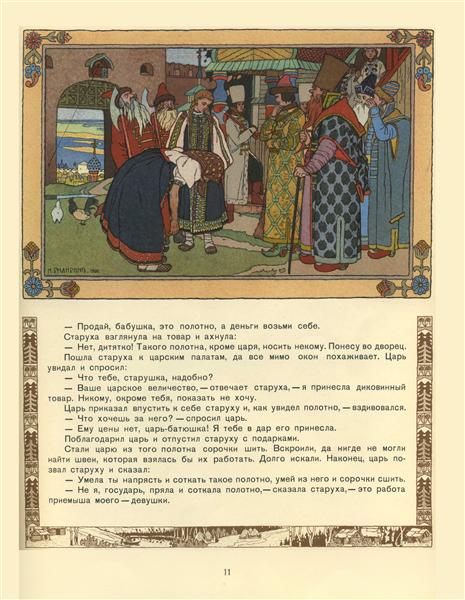Description
The illustration for the fairy tale "Vasilisa la Bella", made in 1900 by Ivan Bilibin, is an exquisite reflection of the mastery and artistic vision of one of the most prominent illustrators of Russian art of the nineteenth and early twentieth centuries. This work, like many others in Bilibin, is a testimony of its ability to combine Russian folk tradition with a modern and distinctive aesthetic.
In this work, Bilibin transports us to the heart of a Russian fairy tale. The scene presents the main character, Vasilisa, standing next to a construction that stands out for its elaborate ornamentation. The architecture itself is a work of art, with intricate geometric and floral patterns that are characteristic of the bilibin style. This attention to detail not only beautifies the painting, but also effectively frames Vasilisa, highlighting its importance in the narrative.
The use of color in the work is equally remarkable. Bilibin uses a rich and varied palette, with terrible and soft tones that permeate the scene of a welcoming warmth, proven by the vibrant details in Vasilisa's clothing and in architecture. The traditional Russian dress that Porta Vasilisa is adorned with sumptuous motifs and bright colors, specifically, red and green that give life and dynamism to the central figure. This use of color is not only aesthetically pleasant, but also serves to highlight the cultural essence of the story and its setting.
In Vasilisa's own figure, Bilibin exhibits a mixture of simplicity and sophistication. His serene posture and the faint glow of his gaze transmit a stillness and internal force that are essential for their character in the narrative. This representation is not accidental; Bilibin was known for his ability to capture the essence of fairy tales characters, providing them with a nobility and authenticity that made them unforgettable.
Another remarkable aspect of the work is the precise and clear line that defines each element of the composition. Bilibin was a master of the linear drawing, and this technique is evident in the clear definition of the forms and the decorative details. The natural environment that surrounds Vasilisa, although not invasive, remains meticulously worked, incorporating ethnographic elements that accentuate the cultural authenticity of the image.
Ivan Bilibin, influenced by his academic formation at the Imperial Academy of the Arts and their trips through North of Russia, developed a style that fused Art Nouveau with Russian popular art. This style is evident in its Illustrations of Fairies, where the symbiosis between the traditional and the contemporary results in a rich and detailed work, but accessible and evocative.
In the context of his career, "Illustration for the fairy tale 'Vasilisa la Bella'" rises as a representative work. Bilibin dedicated much of his life to illustrate the Russian folk stories, and in this illustration you can appreciate the rigor and sensitivity with which he approached each story. His legacy has transcended time, influencing both contemporary artists and Russian art and culture scholars.
In summary, Bilibin Enlightenment is a jewel of visual art that continues to fascinate its exquisite technique, its cultural wealth and its powerful visual narrative. It is a reminder of the ability of art to tell stories that resonate through generations, keeping the echoes of tradition and beauty in every line and color alive.
KUADROS ©, a famous paint on your wall.
Hand-made oil painting reproductions, with the quality of professional artists and the distinctive seal of KUADROS ©.
Art reproduction service with satisfaction guarantee. If you are not completely satisfied with the replica of your painting, we refund your money 100%.

